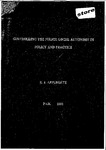CONTROLLING THE POLICE: LOCAL AUTONOMY IN POLICY AND PRACTICE
| dc.contributor.author | APPLEGATE, RICHARD JOHN | |
| dc.contributor.other | Faculty of Arts, Humanities and Business | en_US |
| dc.date.accessioned | 2012-08-01T11:56:11Z | |
| dc.date.available | 2012-08-01T11:56:11Z | |
| dc.date.issued | 2002 | |
| dc.identifier | Not available | en_US |
| dc.identifier.uri | http://hdl.handle.net/10026.1/1061 | |
| dc.description.abstract |
This thesis assesses the influence of The Home Office, Her Majesty's Inspectorate of Constabulaiy, the Association of Chief Police Officers, the Audit Commission, the Local Police Authority, and the Chief Constable on local policy makers and impleinenters within the Devon & Cornwall Constabiilary. It is based on five policy areas: the structmre of the organisation. The Citizens' Charter, Annual Policing (now Performance) Plans, Domestic Violence Policy, and Equal Opportunities Policy. Unlike previous research, it brings together the issues of policy and practice at all levels of the organisation through interviews with senior managers in the Devon & Cornwall Constabulary and members of the Local Police Authority, and questionnaires to front line police officers; as well as analysis of Her Majesty's Inspectorate of Constabulary reports and Police Authority Policing Plans, and recomniendations made in Home Office Circulars and Audit Commission reports. The research was carried out prior to the infroduction of Crime and Disorder Partnerships and Crime Audits, required by the Crime and Disorder Act 1998. Both policy makers and policy implementers believed that there was a sfrong influence from all the key players in the policy areas examined, with the exception of the Association.of Chief Police Officers arid the Local Police Authority: There is-no'^yidence; to suggest that there has been any change in the power relationship between the Chief Constable and the Police Authority. For police officers directly iiivolved in the implementation process. The Citizens' Charter and Annual Policing (now Performance) Plans had made little differerice to the way they carried out their day-to-day work. In these more generic policy areas they saw less influence from the key players but perceived greater influence coming from consumers, public opinion, colleagues and immediate supervisors. In the tighter policy area of domestic violence, where there is greater top down confrol, the mfluence of the key players was the sfrongest, and local autonomy, both in policy and practice was hard to find. The police organisatiori retains many of the attiibutes of a classical bureaucracy and an ideal form of organisational stincture has yet to be found. | en_US |
| dc.description.sponsorship | Faculty of Human Sciences | en_US |
| dc.language.iso | en | en_US |
| dc.publisher | University of Plymouth | en_US |
| dc.subject | DOCTOR OF PHILOSOPHY | en_US |
| dc.title | CONTROLLING THE POLICE: LOCAL AUTONOMY IN POLICY AND PRACTICE | en_US |
| dc.type | Thesis | en_US |
| dc.identifier.doi | http://dx.doi.org/10.24382/1327 | |
| dc.identifier.doi | http://dx.doi.org/10.24382/1327 |
Files in this item
This item appears in the following Collection(s)
-
01 Research Theses Main Collection
Research Theses Main


